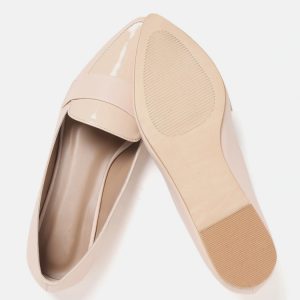As shoe manufacturing company, it’s important to understand the shoes we wear and the process of making them. Not only does this help us make informed decisions when buying shoes, but it also deepens our appreciation for the art of shoemaking.

When it comes to the fit of shoes, it should be noted that the length of European shoe lasts advances and retreats by 6.66%, while the circumference of shoes advances and retreats by 4.5%. For domestic shoes, the length advances and retreats by 5%, and the circumference advances and retreats by 3.5%. It’s also worth noting that the inner and outer circumferences of the human foot are not the same. This is why when making shoes, the inner plate of the shoe should be wider and shorter than the outer plate, especially thong shoes. In addition, if the shoe decoration on the panel is a symmetrical pattern, the inner circumference of the shoe decoration should be 2-3mm shorter than the outer circumference of the shoe decoration to achieve a visually symmetrical effect.
There are multiple steps involved in the shoemaking process, whether done through an assembly line or a board process. In the assembly line, the process includes stamping the midsole, making the midsole, making the panel, drawing the upper, brushing the rubber shoes on the assembly line, shaping the shoe, air drying, inspection, cleaning the upper, and packaging. In the board room process, the steps include plate making, board making, midsole making, board and midsole bonding with shoe materials, and outsole pasting.
In the shoe-making process, three types of glue are used—powder glue, all-purpose glue, and heat-resistant glue. The midsole is pasted with powder glue, the panel and midsole are bonded with universal glue, and the outsole is pasted with heat-resistant glue. In addition, toluene can be used to erase the printed content printed on the shoe surface.
When making sandals, attention must be paid to the comfort of the design. The height between the heel and the midsole of the sandal should be 0.5-1 cm different from the length between the heel and the back strap and the midsole. The height of the back strap of the sandals should also be high on the inside and low on the outside to match the height of the ankle joint. The midline length of the upper of the sandal should be about 4-4.5 cm in order to obtain maximum comfort. Generally, four and a half toes should be exposed on the exposed toes of the toe, the position of the first joint of the thumb is exposed, and the little finger is only slightly exposed.
For those involved in shoe production, it is important to understand the causes of shoe degumming. This can happen if the press does not have enough pressure, there is wind between the upper and sole, the glue is dry and not tacky, or a fan blows to the front of the sole during lamination. Also, it’s important to know how to tell if the glue is completely dry. For water-based glue, if it is not dry, white spots will appear on the surface friction, while for oil-based glue, you can gently scratch the surface with your fingers to see if it can slide.
Finally, treatments and hardeners are important elements when bonding outsoles. The treatment is used to etch away any buildup on the sole, making it easier to adhere, but it is important to allow it to dry completely to be effective. To determine if the treatment is dry, simply smell it – if there is no smell, it is dry. If the outsole material is soft, adding a hardener to the glue can make the sole harder.
As consumers, understanding shoes and the process of making them can help us better appreciate and value the shoes we buy. For footwear producers and collaborators, knowledge of the details and techniques of shoemaking is essential to create high-quality, comfortable and durable footwear.





